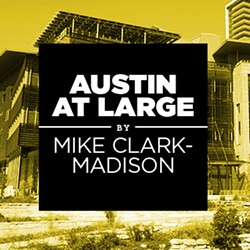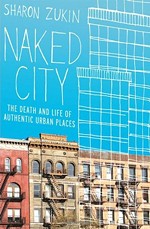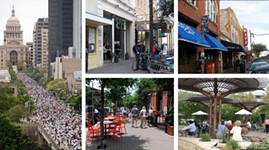Austin @ Large: The Metro Message
It’s not a ‘campaign,’ exactly, but what is the transit authority’s tune?
By Mike Clark-Madison, Fri., June 25, 2004

The essential coyness of the Cap Metro PR blitz is probably understood by most viewers: Public agency, public money, can't "campaign" in the traditional sense for the rail plan you'll be asked to approve (or not) on your November ballot. Nonetheless, the transparency of the agency's current media maneuvers is likewise evident, and we've been asked many times (as has the Statesman) whether the Capital Metro "outreach effort" is legal.
The short answer is yes. News watchers who've been following the Texas Association of Business' legal travails are probably now familiar with the term "express advocacy," the state election code's term of art for what makes an ad a regulated political ad. Now, Capital Metro may, sotto voce, be advocating an express (train, that is), but its "outreach effort" doesn't advocate for anything, other than a maybe-someday bright future without traffic jams and dirty air. Or something.
Government agencies "advocate" for mom, apple pie, and pretty flowers with your tax money all the time – along with more politically fraught causes like drug-free-ness and be-scared-of-the-terrorists-ness – so this is no reason to unduly bash Capital Metro, unless that's your hobby, which for many Austinites it is. It would be illegal for Cap Metro to spend your sales tax money on political advertising, but that presumes the existence, as opposed to the universal expectation, of an actual election; until the transit authority officially calls a referendum and sets a ballot (likely at its board meeting in August), the point is moot. Once that happens, political action committees will spring up like rain lilies and will expressly advocate all over the highway with other people's money. (No contribution limits apply.)
The Little Engine That Won't, Quite
So sure, everybody knows Capital Metro is campaigning for the big Yes vote in November, but can't say so without violating commonly accepted standards of electoral hygiene. But must the agency say – or sing, hum, strum, or whistle – nothing at all as a consequence? Traffic is bad? The air's gettin' funky, as W.C. Clark puts it? Weren't these findings first reported, as Dennis Miller used to say (back when he was funny), in the pages of Duh! magazine?
One supposes that these facts are safe ones for the Capital Metro artist roster to sing about, since they're not only true but objectively verifiable – we've all heard the Texas Transportation Institute findings that Austin is the most congested city of its size in the nation, and we've all been watching the metro area's flirtation with nonattainment of federal air-quality standards. But then why spend a lot of money trumpeting them? Little birds tell me that polls and focus groups reveal that – despite the hyperbole of the road warriors – people, particularly people in the Birkenstock Belt, really aren't that troubled by Austin traffic. (They do care about air quality, but that still seems some distance away from a crisis point.) They care more about jobs and about affordability, and they understand that as Austin grows bigger and more "urban" it will become more congested.
It's the folks in the suburbs who think traffic jams in Oak Hill and the Northwest Corridor are harbingers of the End Times, but they're also skeptical of both solutions currently on offer – transit and toll roads. They're thus susceptible to the sweet songs of the Gerald Daugherty Congregation, whose signature tune – "Gimme Cap Met's Money!" – has been bubbling under the charts now for, oh, 15 years or so. To offset that, Capital Metro will need the Central Austin vote in November in all its usual one-sided glory, the boxes that voted for light rail by 4-to-1 (or more) margins in 2000.
The urbanites are still gung-ho for transit – so gung-ho, in fact, that many are unlikely to be satisfied with Capital Metro's current rail plans, described by one activist as "the little red train that comes from the suburbs." If they don't think transportation is really such a big crisis, they may be tempted to hold off their support until Cap Metro brings back real live light rail, which came so close to winning four years ago. And that would never do.
Same Old Song?
This is just one theory, and it may bear scant relation to the actual decision-making down at Fifth and Pleasant Valley. But one hopes the Cap Met HQ crew has reason to be confident that throwing traffic and air quality back on the table offers benefits to the cause that offset the risks. Remember the six words that helped kill light rail in 2000: "Costs too much, does too little." It's hard to argue that the current Cap Metro "vision" costs too much, but if – as they were four years ago – traffic and air quality are the benchmarks on which it should be judged, it does even less.
That is, unless – he says, making himself tiresome – the future transit system is linked, inextricably and from day one, with changes in local land use. Four years ago, I argued that a successful rail system had to go where the people already are, which meant the expensive and disruptive Green Line down the Lamar/Guadalupe corridor that Cap Metro was proposing. What's changed in the last four years is most obviously symbolized by Envision Central Texas; infill and density are hot concepts, even with all the problems and fears encountered when trying to put them into practice.
Capital Metro is lucky to have a wealth of opportune locations for New Urbanist development – from Leander to Lakeline to Robinson Ranch to Mueller to Featherlite to the Saltillo District – all along its existing freight-rail right of way, the Red Line. Indeed, none of the visions and plans advanced for those low-hanging-fruit sites will really work without transit service that's more robust than anything that exists in Austin now. This argument, in my opinion, should not be an afterthought here; it should be the core of Capital Metro's message. The little red train can help bring people and jobs back from the fringe into the city, where they belong.
But the longer Capital Metro and its band of minstrels lead the community in the same old songs around the same old campfire, the more difficult it will be to write a new song. Today's traffic and air-quality problems are the result of land-use decisions made 20 years ago, often in the face of great opposition, but usually with the support of the same people who now bitch most loudly about the traffic. There's precious little any transportation system – road or rail – can do about them now. But one way to keep those problems from getting exponentially worse is to change the way we build and grow, and where, and provide the transit systems that will support the new model. In that sense, the real audience for Capital Metro's music will be our children and grandchildren. Will they still dance to it? ![]()
Got something to say? The Chronicle welcomes opinion pieces on any topic from the community. Submit yours now at austinchronicle.com/opinion.








